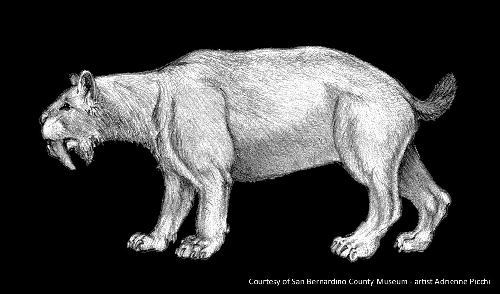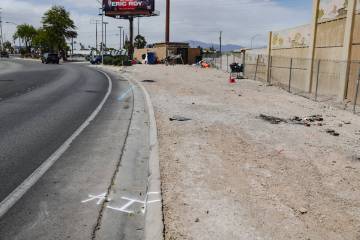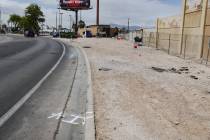Saber-tooth cats found to be part of Las Vegas’ past
Researchers digging in the hills north of Las Vegas have unearthed the bones of an iconic predator and solved an ice age cold case.
A team from California's San Bernardino County Museum has positively identified a pair of fossils dug up in June as two front leg bones from a saber-tooth cat.
Such a discovery would be rare anywhere, but this marks the first of its kind in the fossil-rich Upper Las Vegas Wash, which has been proposed for designation as a national monument.
The find confirms what experts have long suspected: The mammoths, camels and bison that once roamed Las Vegas were stalked by the Pleistocene's most famous meat-eater.
"We knew it had to be there," said Kathleen Springer, senior curator for the museum. "There was all this amazing lunch everywhere."
Springer heads a team that has been studying the wash for a decade and collecting fossils there under a contract with the U.S. Bureau of Land Management since 2008.
The team has unearthed thousands of bones from ice age creatures, but only a handful of fossils from extinct predators have ever been found - and nothing as famous as this.
"The saber-tooth cat is right up there with the T. rex. That's the one everyone recognizes," Springer said.
Eric Scott, the museum's curator of paleontology, was involved in the discovery from start to finish. He first identified the site during survey work in the Upper Las Vegas Wash in 2003.
When the bones were finally excavated over the summer and taken back to the museum in Redlands, Calif., Scott spotted them in the lab and scooped them up before they were even done being processed.
"They just looked funky," he said. "I saw them on the prep table, and I got a little impatient."
Scott started by comparing them with the bones of present-day animals. He said they looked a lot like the leg bones of a mountain lion, but "they were way too big."
On the day after Thanksgiving, he drove the fossils to the Page Museum at the La Brea Tar Pits in Los Angeles. They matched up perfectly with saber-tooth bones in that collection.
For Scott, it was a journey home of sorts. He got his start in fossil research as a 16-year-old volunteer at the La Brea Tar Pits in 1978. Springer jokingly referred to him as "a boy paleontologist."
Scott said large carnivores are rare in the fossil record, just as they are in the natural world. If predators outnumbered prey, everyone would eat each other, and there would be no animals left.
"To come up with a meat-eater (fossil) at all is unusual. It showcases the significance of the site, even in terms of the rare animals," Scott said. "We're pretty excited about it."
Asked whether researchers plan to return to the site and dig for more saber-tooth bones, an enthusiastic Springer said, "Oh yeah we will."
Before it died off at the end of the last ice age, the saber-tooth cat grew to the size of a modern African lion and hunted many of the Pleistocene's large plant-eaters.
In addition to its signature, foot-long fangs, the cat sported a bobbed tail and a body built for speed.
There is some debate about the animal's behavior, but current research suggests it may have lived in social groups and probably ambushed its prey rather than chased it.
The discovery adds to the intrigue that surrounds the Upper Las Vegas Wash, which has attracted geologists and paleontologists for more than a century.
The area is of particular interest because the rock where the fossils are found dates back a quarter of a million years and contains a startlingly specific chronology of climate change over several ice ages.
The saber-tooth fossils, for example, are thought to be 15,593 years old, "plus or minus," Springer said. "We have a really good carbon date on these deposits."
The Bureau of Land Management has limited public access to the area while Springer and company continue their work.
A bill was introduced in Congress in June seeking to designate 22,650 acres as the Tule Springs Fossil Beds National Monument. The sawtooth-shaped swath of land borders Las Vegas, North Las Vegas, Floyd Lamb Park and the Desert National Wildlife Refuge.
The measure was introduced in both the House and Senate but failed to advance. The legislation probably will have to be brought back for consideration during the next session of Congress.
In the meantime, Springer said the bones of Las Vegas' only known saber-tooth are still being studied. There are no immediate plans to display them, but she expects that to happen eventually.
Scott said the timing of the find couldn't have been better. The museum's team is just finishing work on a major paper describing all the extinct animals that have been identified in the Upper Las Vegas Wash.
"I'm really glad to be able to add saber-tooth to the list," he said.
Contact reporter Henry Brean at hbrean@reviewjournal.com or 702-383-0350.





























